A History of Britain in Its Pub Signs
by Elaine Saunders
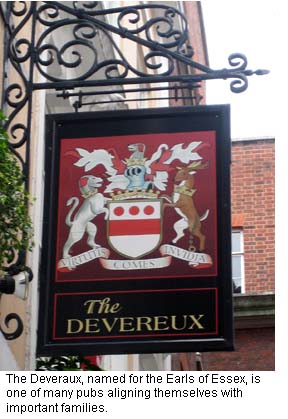 As far as
time-travel goes, a walk down any High Street in Britain can take
an explorer back across centuries. As far as
time-travel goes, a walk down any High Street in Britain can take
an explorer back across centuries.
Few people realise that two thousand years of history is hanging
over their heads, and that the humble pub sign can hold the key
to a town's past. Pubs were rarely named by accident but were
inspired by religion, royalty, heroes and the occasional scandal.
Knowing how to read the signs means that any visitor can
unlock the history of the inn and learn a great deal about its
former customers.
When the Romans invaded Britain in AD43 they brought hot baths,
straight roads and the first real pubs with them. In Rome,
landlords of these tabernae hung bunches of vine leaves
outside as a simple sign but, upon reaching Britain, they had to
improvise. They used any evergreen plant and it's still possible
to find pubs called The Bush or The Hollybush up
and down the country.
Roman roads such as Fosse Way and Ermine Street opened up Britain
to long-distance travel and large numbers of troops moving around
the country needed to be fed and watered along the way. Roadside
inns opened at regular stages -- much like today's motorway
service stations -- where travellers could find food, drink and
sometimes a bed for the night. Modern roads still follow the
route of these ancient highways and it's not inconceivable that
some of the roadside inns have been on the same site for
centuries.
By the 12th Century large groups were once more taking to the
roads, this time in pursuit of pilgrimage. Following the murder
of Thomas à Beckett in Canterbury, pilgrimages to his
shrine, and other cathedrals around the country, became
fashionable. One such journey was described by Chaucer in his
Canterbury Tales in which pilgrims set out from the
Tabard in London, a real inn of the time.
Traditionally, travellers sought overnight accommodation in the
many monasteries along the way but the numbers became so great
that the monks could no long cope with the influx. Enterprising
locals therefore set up private inns and took religious names to
imply a monastic connection. However, the population was largely
illiterate so pictorial signs were used to advertise the inns
instead of lettering. The images were probably copied from
churches' stained glass windows -- the pictures of saints, angels
and arks being both familiar and easy to reproduce.
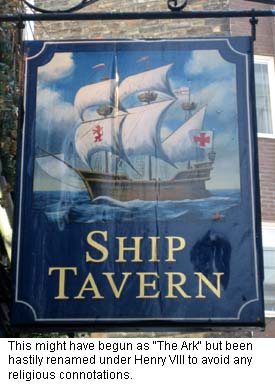 These religious influences
on British pub names would have continued indefinitely had Henry
VIII not been desperate for a male heir. Realising that Catherine
of Aragon could not give him a son, he sought to divorce her and
marry Anne Boleyn. When the Pope refused, Henry broke from the
Catholic faith and established his new Church of England in the
16th Century. He systematically destroyed the monasteries and
confiscated their wealth whilst pubs rushed to change their names
to eradicate any Catholic links. Arks became Ships
and St Peter, the guardian of the gates of Heaven,
became the Crossed Keys. Many more landlords played safe
by adopting loyal names like the Kings Arms or Kings
Head. These religious influences
on British pub names would have continued indefinitely had Henry
VIII not been desperate for a male heir. Realising that Catherine
of Aragon could not give him a son, he sought to divorce her and
marry Anne Boleyn. When the Pope refused, Henry broke from the
Catholic faith and established his new Church of England in the
16th Century. He systematically destroyed the monasteries and
confiscated their wealth whilst pubs rushed to change their names
to eradicate any Catholic links. Arks became Ships
and St Peter, the guardian of the gates of Heaven,
became the Crossed Keys. Many more landlords played safe
by adopting loyal names like the Kings Arms or Kings
Head.
Henry VIII sold off the monastery lands to the highest bidder and
granted peerages to his supporters so some landlords aligned
themselves with the new incoming lord of the manor, giving us
names like the Devereux Arms or the Duke of
Norfolk.
The king was also a great sportsman, a fact celebrated in pub
signs. Near hunting grounds there are plenty of pubs called
The Greyhound (Henry's favourite hunting dog) or The
Bird in Hand for his love of falconry. Other common sporting
signs include the Fox & Hounds, Dog & Duck or
Hare & Hounds.
Landlords soon realised that pub signs could also advertise the
entertainment on offer. Ye Olde Fighting Cocks in St
Albans is a perfect example and claims to be the oldest pub in
Britain. It used to be the dovecot for St Albans Abbey but after
the Dissolution of the Monasteries, a clever businessman realised
its circular shape would make it the perfect venue for
cock-fighting. Many pubs with cock in the title would have
held cock fights whilst the Bull advertised bull-baiting
and the Bear bear-baiting.
Yet more pubs associated themselves with the area's predominant
trade as a way of gathering custom, such as the Golden
Fleece (for the local wool trade). Bricklayers,
Blacksmiths and Carpenters Arms were meeting places
for local tradesmen and often acted as unofficial employment
exchanges. A craftsman moving to the area would seek out such a
pub where the landlord could introduce him to an employer or
extend credit until he established himself in business.
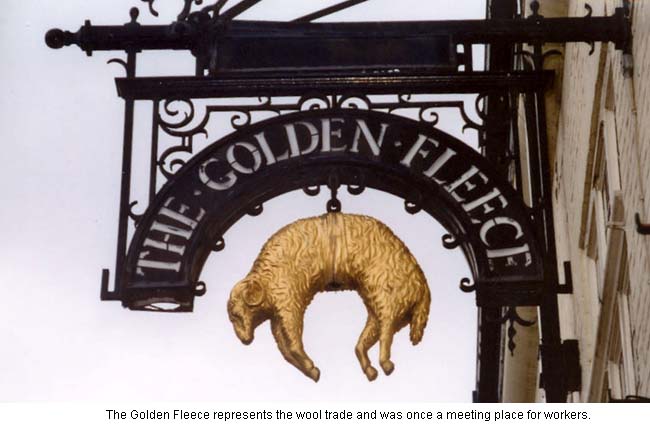
Landlords regularly offered banking services to customers and
allowed employers to pay their workers on the premises. By the
18th century, the larger inns on stage-coach routes had become
sophisticated commercial centres with strong rooms, storage
facilities and lines of credit for businessmen.
Pub signs now began advertising the services on offer to the
hundreds of passenger coaches and commercial vehicles. Coach
& Horses, Horse & Groom, Wheelwrights and Farriers
Arms sprang up along the major routes. It's easy to recognise
a former coaching inn as many still have high arches from the
street to the stable-yard behind, where grooms, porters,
coach-repairers and blacksmiths worked hard to keep traffic
moving.
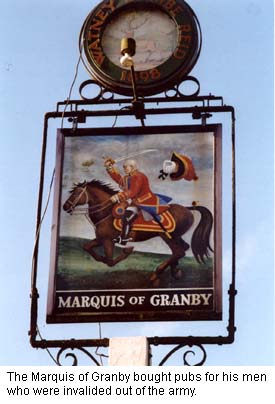 However, not only the
tavern owners flourished -- highwaymen made the most of the rich
pickings and are occasionally remembered on pub signs. One such
was Lady Katharine Ferrers of Markyate, Hertfordshire, who turned
to highway robbery out of boredom and to repay her gambling
debts. She preyed on the main London to Birmingham road,
relieving one traveller of today's equivalent of £60,000.
Most highwaymen would kill for a few coins, however. The
Wicked Lady at Wheathampstead, Hertfordshire, stands on
the spot where she was fatally wounded in 1660. However, not only the
tavern owners flourished -- highwaymen made the most of the rich
pickings and are occasionally remembered on pub signs. One such
was Lady Katharine Ferrers of Markyate, Hertfordshire, who turned
to highway robbery out of boredom and to repay her gambling
debts. She preyed on the main London to Birmingham road,
relieving one traveller of today's equivalent of £60,000.
Most highwaymen would kill for a few coins, however. The
Wicked Lady at Wheathampstead, Hertfordshire, stands on
the spot where she was fatally wounded in 1660.
The Industrial Revolution brought untold wealth to Britain and
commercial traffic increased hugely. Industrialists abandoned the
roads and built canals to carry coal and raw materials to their
factories. Pubs like the Waterway or the Navigation
were built along the banks to serve the watermen, many of whom
lived on their boats with their families. But by 1850, the
faster, cheaper railways had superseded the canals and every town
soon boasted its Railway Tavern or Station Arms.
Pub signs have also been used as affectionate tributes and
commemoration. Heroes like Nelson and Wellington
have pubs named after them, as do famous battles, ships and naval
engagements. One affectionate tribute is reserved for the
Marquis of Granby, a British army commander much loved by
his men. In the 18th century there were no army pensions and,
rather than let his men starve, he bought pubs for every one of
his disabled non-commissioned officers. He died over
£37,000 in debt (£4million today) but the many pubs
bearing his name are a fond memorial.
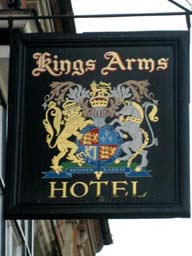 Pubs are a familiar sight in town and country but many of
the names crop up more often then others. Every town has its own
Crown, Red Lion and Royal Oak but what's the
particular history behind them? Why are they so popular? Pubs are a familiar sight in town and country but many of
the names crop up more often then others. Every town has its own
Crown, Red Lion and Royal Oak but what's the
particular history behind them? Why are they so popular?
Compared with many of Britain's pub names, The Crown is
relatively new, having become popular as late as 17th century. At
that time, King Charles I's disputes with Parliament had spilled
over into civil war, the Parliamentary army being commanded by
Oliver Cromwell. Despite fleeing to Scotland, King Charles was
eventually captured, tried and executed in 1649, his son was
exiled and Cromwell assumed power.
Cromwell was a Puritan and deeply religious, and he effectively
prohibited most forms of enjoyment. Pubs and theatres closed,
sports were banned and colourful clothing and cosmetics were
forbidden. The country wore black, as if in mourning for the
entertainments it had once enjoyed and even Christmas was
outlawed.
Cromwell's death and the restoration of King Charles II heralded
a new era of indulgence. Theatres reopened for the performance of
the new, bawdy, comic Restoration plays whilst ale flowed in
taverns once more. Landlords were so relieved at the return to
business that pubs were renamed The Crown in Charles'
honour.
Crown also appears in another popular name -- Rose
& Crown. There are two theories behind this name, the
first coming from another civil war, the Wars of the
Roses. Sibling rivalries in the 14th century lead to war
between the houses of Lancaster (whose supporters wore red roses)
and York (who wore white). In the Battle of Bosworth in 1485,
Lancastrian Henry Tudor defeated and killed the Yorkist King
Richard III and crowned himself Henry VII. He then married the
old king's beautiful niece, Elizabeth the Rose of York, and they
went on to found the great Tudor dynasty. Pubs were named in the
couple's honour, Rose & Crown.
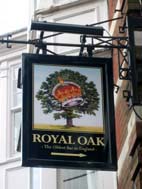 The last Tudor monarch, Elizabeth I, may
unwittingly have influenced the second explanation of this name.
When she died, she appointed King James of Scotland as her heir.
It is said that pubs called the Crown added an English
rose to their signs, implying that their loyalty to a Scottish
king must always take second place to their Englishness. The last Tudor monarch, Elizabeth I, may
unwittingly have influenced the second explanation of this name.
When she died, she appointed King James of Scotland as her heir.
It is said that pubs called the Crown added an English
rose to their signs, implying that their loyalty to a Scottish
king must always take second place to their Englishness.
The Tudors may also have influenced the next pub sign, the
Swan. Anne of Cleves, the fourth wife of Henry VIII, had a
white swan as her family crest and pubs are said to have adopted
this name as a tribute to her. As the marriage was annulled after
six months however, it's unlikely to be the true explanation.
Henry IV's wife, Mary de Bohun of Hereford, also had a white swan
in her coat of arms, as did Margaret of Anjou, wife of Henry VI.
However, this sign could easily have been connected with the
ancient trade guilds. The reigning monarch still owns all swans
on open water but, in the 15th Century, the Worshipful Companies
of Dyers and of Vintners were both granted rights of ownership.
The Swan could have been a meeting place for workers in
either of these trades. Roasted swan was also served at
ceremonial banquets so a pub by this name could have implied fine
dining.
As well as royal associations, many pub names have religious
connections. Masons building a church would have stayed at the
local inn and many took an ecclesiastical name upon completion.
The ones rebuilding St Brides church after the Great Fire of
London stayed in the Old Bellin Fleet Street. Bells were
believed to have magical powers, protecting against evil spirits
and lightning. Before today's urban noise, bells ringing out to
summon the faithful to prayer or sounding curfew would have been
far more noticeable. No wonder names like Bell, Old Bell, Six
Bells and Eight Bells are so often seen.
The ark has also been symbol of the church: a ship's masts are in
the shape of a cross and the centre of the church is the
nave, which comes from the same word root as
navigation. When Henry VIII renounced the Catholic faith
in the 16th Century to create his new Church of England, many
pubs abandoned names implying Catholic allegiance. Kings Head
or Kings Arms suddenly became very popular and any pub
called the Ark could have become the Ship.
However, a ship was also a very easy image for
signwriters to draw and would also have been popular in coastal
areas or naval ports.
Some ships even had pubs named after them, like the Royal
George, which sank in 1782 with massive loss of life, or the
Royal Oak, torpedoed in the first weeks of World War II
with 833 fatalities.
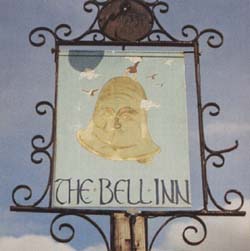 Most pubs called the Royal Oak
usually show a painting of a tree with a crown resting in the
branches. This takes us back once more to the English Civil War
when the future Charles II was on the run from Cromwell's army.
He remained undiscovered for a day in the branches of an oak tree
in Boscobel wood, even though Cromwell's men were on ground
below. On Charles II's restoration, this became a popular story
and a great number of pubs took the name. Most pubs called the Royal Oak
usually show a painting of a tree with a crown resting in the
branches. This takes us back once more to the English Civil War
when the future Charles II was on the run from Cromwell's army.
He remained undiscovered for a day in the branches of an oak tree
in Boscobel wood, even though Cromwell's men were on ground
below. On Charles II's restoration, this became a popular story
and a great number of pubs took the name.
A far less popular king was George IV, who reigned from 1820 to
1830, and lived an excessively extravagant lifestyle. He was
hugely overweight, addicted to laudanum and father of several
illegitimate children. He married Caroline of Brunswick to
discharge his debts but was hateful to her and they separated
within a year of marriage. He was once described by the Duke of
Wellington as "selfish, ill tempered and without one redeeming
quality." It's strange therefore that there should be so many
pubs called the George showing a handsome Regency dandy on
their signs.
Another figure widely disliked was John of Gaunt, the fourth son
of Edward III and the richest man in England in the 14th Century
(his annual income exceeded £5 million at today's rates).
He founded the House of Lancaster, was part of the feud that led
to the Wars of the Roses and crushed the Peasants' Revolt of
1381. It's highly unlikely therefore that he inspired the Red
Lion so often seen.
Another theory is that James I decreed that the Red Lion
of Scotland should be displayed outside all public buildings, but
that would surely have lead to almost every pub adopting the
name. In fact, lions were a popular heraldic device in black,
blue, red, gold and white, and all have appeared on pub signs.
Landlords might have given their pubs the name Red Lion to
gain the patronage of the local lord, or a dignitary with this
crest could have visited the inn at one time.
The final sign is connected with neither religion nor royalty but
was inspired by the Victorians' love of innovation. The
Industrial Revolution brought economic and technological success
to Britain, and in the 1830s the construction of a vast railway
network began. Soon most towns in the country had a station, and
hotels were built to cater for the new passengers. Like those on
the old coaching routes, the pubs took names like the Railway
Tavern or Station Arms as a way of attracting the
travelling public.
Defining the origins of pub names is not an exact science because
history is open to a great deal of interpretation (and
misinterpretation). However, pub signs are like snapshots from
time, every one of them capturing an historical event or era.
These pictures have been handed down to us across the centuries
and carry these stories forwards even if, most of the time, the
stories literally pass over our heads.
Pub signs are collectively a unique record of Britain's history
-- religious, industrious and scandalous. Many are also
beautifully-crafted works of art on public view. So the next time
you're walking down the High Street, make sure you stop, look up
and read the signs. There's a world of stories hanging over your
head.
Related Articles:
- The Historic Pubs of London, by Pearl Harris
- https://www.timetravel-britain.com/articles/london/pubs.shtml
- Haunted Pubs of England, by Dr. Gareth Evans
- https://www.timetravel-britain.com/articles/history/hauntedpubs.shtml
- A Beginner's Guide to British Pubs, by Graham Hughes
- https://www.timetravel-britain.com/articles/travel/pubs.shtml
More Information:
We regret that we no longer have the resources to maintain up-to-date links and/or hours and pricing details for the various sites and attractions listed on this website. For more information about the location(s) listed above, please use your favorite search engine or visit Wikipedia.
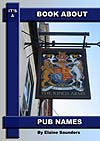 |
Elaine Saunders is a freelance writer based near London. Find out more about the history of pubs and pub names in her e-book, A Book About Pub Names, which contains over 100 illustrations together with dozens of links to specialist websites. It's a comprehensive guide to the history of Britain's pubs and pub signs with chapters on their history, old trades and occupations and drinking measures.
|
Article and photos © 2008 Elaine Saunders
| 